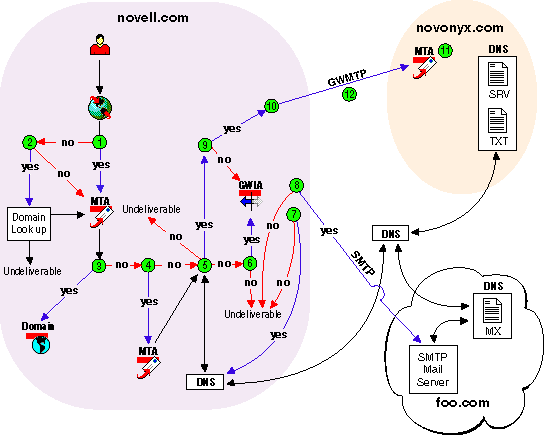3.7 Message Flow through a Dynamic Internet Link
The following diagram illustrates the basic process of establishing a dynamic Internet link between GroupWise systems.

3.7.1 Stage 1: GroupWise Client in the Sending System
The GroupWise client parses the address by breaking it down into parts and attempting to map it to the userID.post_office.domain syntax. When the parsing is complete, the client looks in its own GroupWise Address Book and asks: “Does the parsed address match any listed in the GroupWise Address Book?”
The address can be typed by the user or obtained from the GroupWise Address Book.
-
If Yes: The GroupWise client sends this “internal” message to the MTA to be queued for delivery.
-
If No: The GroupWise client attempts to resolve the address further. Go to Stage 2.
3.7.2 Stage 2: GroupWise Client in the Sending System
The GroupWise client checks the Internet domain addressing element listed after an @ sign in the address syntax and asks: “Is this Internet domain defined in my GroupWise system (that is, is it internal)?” If there is no Internet domain element at this point, the message is undeliverable.
-
If Yes: The client looks at the address to determine if all parts are present. If they are present, it attempts to find a domain element in the address and resolve the address for local delivery. If a domain element cannot be found, the message is undeliverable.
-
If No: The client recognizes the Internet domain as external to its system and queues the message to the MTA. Go to Stage 3.
3.7.3 Stage 3: GroupWise MTA in the Sending System
The GroupWise MTA asks: “Does the Internet domain in this address match any Internet domain defined in the local GroupWise system?”
-
If Yes: The GroupWise MTA recognizes that the Internet domain is internal and routes it to the internal domain.
-
If No: The GroupWise MTA cannot find a matching Internet domain in its system. The GroupWise MTA attempts to find a resource to help it route the message. Go to Stage 4.
3.7.4 Stage 4: GroupWise MTA in the Sending System
The GroupWise MTA checks its system and asks: “Has a route been defined to an alternate MTA configured for Internet domain service?”
3.7.5 Stage 5: GroupWise MTA in the Sending System
The GroupWise MTA asks: “Is this system set up to support DNS lookups?”
3.7.6 Stage 6: GroupWise MTA in the Sending System
The MTA checks the system for capability to establish SMTP links and asks: “Does this system have a designated GroupWise Internet Agent?”
-
If Yes: Go to Stage 7.
-
If No: The message is undeliverable.
3.7.7 Stage 7: GroupWise Internet Agent in the Sending System
The MTA passes the message to the designated GWIA in this GroupWise system. The GWIA checks DNS and asks: “Does DNS have a mail exchange record (MX) for this other system that I can use to establish an SMTP link?”
-
If Yes: The GWIA does a DNS lookup for an MX record. Go to Stage 8.
-
If No: The message is undeliverable.
3.7.8 Stage 8: GroupWise Internet Agent in the Sending System
The designated GWIA establishes an SMTP link with the Internet domain in the address, converts the GroupWise message to SMTP format, and sends the message to the other messaging system through the SMTP Internet connection. No further information about the message is returned to the sender unless the addressee (or the addressee’s mail server) replies.
3.7.9 Stage 9: GroupWise MTA in the Sending System
The MTA performs a DNS lookup at the DNS name server by asking: “Does DNS have an SRV or TXT resource record associated with this Internet domain name?”
3.7.10 Stage 10: GroupWise MTA in the Sending System
The MTA reads the name-to-TCP/IP address mappings listed in the resource record for the other GroupWise system’s MTAs, chooses a domain to connect to based on a priority system established in the resource record, and initiates a GroupWise Message Transport Protocol (GWMTP) connection procedure with an MTA in the other system (sending to its port and address). Go to Stage 11.
3.7.11 Stage 11: GroupWise MTA in the Receiving System
The receiving MTA recognizes the sender’s attempt to connect, then completes the GWMTP connection with the sending MTA. Go to Stage 12.
3.7.12 Stage 12: Both GroupWise MTAs
The message is sent unaltered over the GWMTP connection between the two GroupWise MTAs.